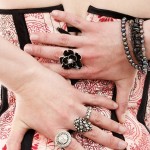How to Remove the Corset of Addictive Patterns
by Z Zoccolante
In the midst of her novel Lost and Found, Carolyn Parkhurst includes a beautiful paragraph about studying the remains of women long ago, and how we might find their bones bent into the shapes of their corsets. “You’ll see that after all those years of stricture and compression, the constant embrace of whalebone and satin and steel, her body has changed its very form.”
She goes on to wonder if women would have been able to give up the corset if they’d wanted to. “I wonder if, after a lifetime of being bound and held, it was something of a comfort to be laced in tight. Without it, their bodies must have felt wrong – the wobbly flesh, the ungainly freedom. I wonder if they missed the pressure . . .”
Any addictive pattern is usually accompanied by the feeling of being trapped, of being constricted and held tightly in a way that one cannot fully control. The corset is a perfect metaphor for this structure.
Listen to or download the podcast of this blog.
Hidden mp3 player
To become a member, click on REGISTER on the sidebar to the right!What resonated most with me were the questions that came after the corset. After a lifetime of being bound would someone choose freedom?
Despite knowing our addictive patterns aren’t good for us, and wanting to be free of them, our bodies and minds resist change. We’re creatures of habit that don’t thrive on surprise or what we perceive as a loss of control. We often think we’re better to stay with the devil we know than to risk going out into the unknown.
Let’s think about it from our brain’s point of view. Pretend that your mind is a huge beach of damp sand. To avoid the discomfort of the wind or the hot sun, you’ve found the quickest path to get to the palm tree, where there’s shade and fresh, juicy coconuts.
When you begin on this path, you don’t notice the sand you’re displacing with every step. Over the days, weeks, and months, a ravine is created in the sand from your constant motion. Every time you take this one path, the ravine gets deeper. One day you notice that you’re walking in a tunnel underground, with a blue sky hovering above you.
The neural pathways of our brain operate the same way. The more we use a certain pathway the stronger and “deeper” it gets. If that neural pathway is an addiction or a destructive pattern, it becomes like a deep ravine and it becomes the only path we choose in all situations.
 But it makes sense. Over time, we’ve built a sand tunnel to get us straight to the shade of our tree. Over time, the tunnel becomes our first and only choice of travel when walking along the beach.
But it makes sense. Over time, we’ve built a sand tunnel to get us straight to the shade of our tree. Over time, the tunnel becomes our first and only choice of travel when walking along the beach.
This wouldn’t be a problem if the tunnel led to something positive and uplifting, like shade and a juicy coconut. Problems arise when the tunnels lead to something negative like a substance or behavior addiction. By the time we want to stop using a drug or repeating a pattern, we often realize that we can’t stop because the tunnel has grown so deep and it’s become our only means of travel in the world.
 So where’s the hope? The hope lies in neuroplasticity.
So where’s the hope? The hope lies in neuroplasticity.
This term basically says that our brains are malleable and capable of change. Scientists have discovered that we’re able to create new neural pathways, where once it was thought that we could not.
This means that we’re not trapped in our destructive patterns. We’re not forced to continue to walk in our sand ravine, or to stay bound by a tight-fitting corset.
Addictions are complicated and do require assistance to heal, but the story of the corset reminded me of something that hinders us all from seeking help and healing:
The truth is we don’t know who we’d be without the corset of our addictions.
Our dysfunctional patterns offer us something we crave. Perhaps drugs offer us fleeting moments of peace. Codependency may be how we experience love. Starving ourselves may make us feel proud. Binging and purging might stuff the voice that says we’re worthless.
These addictions, although destructive, have surfaced because we’ve sought them out to fill a need.
Who would we be without them? How would we get our needs filled if we didn’t have our addiction?
This is the image of the corset – We despise being trapped but we fear being free.
After my eating disorder addiction, after what felt like a lifetime of being bound, after the terror of visualizing wobbly freedom, and the reality of the corset coming undone, I see that the corset wasn’t me, that I was never meant to be compressed in whalebone and satin and steel. After a decade of changing my body’s form, I see now the illusion of comfort the corset brought.
Forward Locomotion:
Today, if you struggle from an addictive pattern know that you’re not a bad person no matter what the voice of your addiction tells you. The addiction, although in an unhealthy way, fills something you desperately need. What is that need?
Then begin to visualize what your life might be if you no longer wore the corset of your addictive pattern. How would you feel in your body? How would you feel in your mind? How would you move through the world differently?
At first, these questions might be terrifying, because leaving any addiction is metaphorically akin to leaving an abusive relationship. We have to relearn how to be with ourselves without the corset.
Begin to think forward to your imagined life of freedom. What might that look like to you? What does it feel like? How are you different?
Although the process may be complex, the question that begins the road to healing is so simple.
Would you rather be bound or be free?
Get help:
If you’re struggling with a substance or behavioral addiction please find a therapist in your area. Check out: How to Find a Therapist you Love.
If you’re in recovery from an eating disorder or behavioral addiction, or are committed to changing a negative mindset, you may be a good fit to coach with me.

8 July, 2015
EXCELLENT BLOG WITH MANY DIFFICULT ISSUES TO RESOLVE WHEN WE FINALLY COME TO REALIZE THAT IT IS US AND NOT THE OTHER PERSON IN THE LIME LIGHT. AT SOME POINT ONE REALIZES THAT THE FACE IN THE MIRROR HAS TO DEAL WITH REALITY. KEEP THEM COMING.